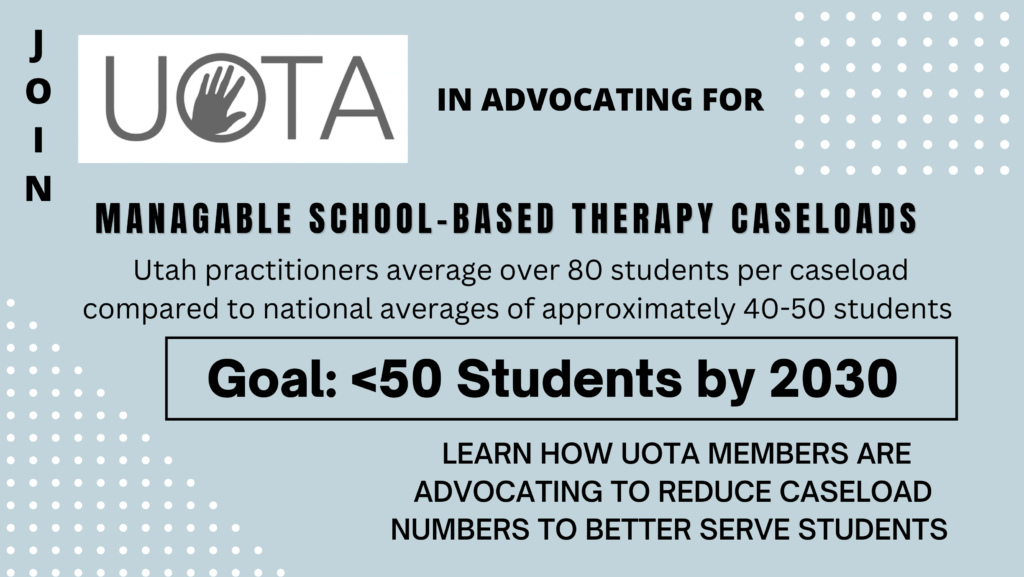
Utah’s school-based occupational therapy practitioners have a huge problem- literally. On average, occupational therapy practitioners report serving twice as many students than the national average and that large caseloads are the number one barrier to providing occupational therapy services across Utah’s public schools (Chamberlain, 2021). The Utah Occupational Therapy Association (UOTA) Government Affairs Committee is currently exploring ways to help reduce caseloads to no more than 50 students per full-time OTR and 75 students per full-time OTR and COTA team by 2030.
The Government Affairs Committee recognizes that school-based occupational therapy practice varies across the State. A 2020 survey of Utah’s school-based occupational therapy practitioners revealed that the survey participants followed an average of 81 students on an IEP and five students on a 504 for each full-time practitioner (Chamberlain, 2021). Some occupational therapy practitioners reported caseloads that reflected the national average of 40-50 students per OTR using a direct service model, while other practitioners exclusively used a consultative model to follow 200-300 students.
Although occupational therapy practitioners recognize that large caseloads are a major barrier to school-based practice, it is less clear how the UOTA, state and local school leaders, occupational therapy teams, and individual practitioners should address this barrier. The Government Affairs Committee believes that there are many solutions to reduce therapy caseloads and that these solutions involve the efforts of all stakeholders. Large caseloads are not unique to occupational therapy. The UOTA is currently reaching out to the Utah Physical Therapy Association and the Utah Speech and Language Association to seek solutions that address unrealistic therapy caseloads across Utah's public schools. To increase stakeholders’ understanding of the breadth and depth of this problem, the Government Affairs Committee has gathered important resources including research, professional documents, and websites. We invite you to use these resources to seek solutions that reduce caseloads. The Government Affairs Committee meets monthly and welcomes the voices of the UOTA membership. Please help us advocate for manageable caseloads of no more than 50 students per full-time OTR and 75 students per full-time OTR and COTA team by 2030.
Sincerely,
The UOTA Government Affairs Committee
RESOURCE |
SUMMARY |
| The areas of occupation addressed by Utah’s school-based occupational therapy practitioners and the factors that influence school-based practice. | Findings from the 2020 Utah School-based Occupational Therapy Survey and related focus groups. |
| What is a reasonable caseload? Current trends in school-based practice. | Summary of national caseloads. The authors suggest reframing job-related tasks into a workload. |
| Garfinkel & Seruya Caseload to Workload Resources | Identifies which states have caseload caps and workload guidelines. Research on 3:1 service delivery model. |
| Workload approach: A paradigm shift for positive impact on student outcomes. | Joint statement by national therapy associations advocating for workload-focused discussions and therapy implementation. Reference to 3:1 Service Model to manage the workload on a month-to-month basis. |
| A workload analysis approach for establishing speech-language caseload standards in the schools: Guidelines. | Guidelines provided through ASHA to help determine caseload standards for school-based speech therapists. |
| Guidelines for occupational therapy services in early intervention and schools. | AOTA document that describes the breadth and depth of school-based OT practice. To provide occupational therapy as intended, OT practitioners must have a reasonable caseload. |
| Consensus statement on clinical judgment in health care settings | The national therapy associations remind licensed practitioners to exercise their clinical judgment in providing care. |
| Recommended practices to organize and deliver school-based services for children with disabilities: A scoping review | This scoping review identifies 10 principles for organizing and delivering services in the school setting. The strict use of only using direct service or consultation will not meet all students’ needs. OT practitioners must exercise their clinical judgment. |
| Enabling participation of students through school-based occupational therapy services: Towards a broader scope of practice. | When practitioners face large caseloads, they narrow their practice domain. This article pushes against large caseloads by encouraging OT practitioners to focus their attention on student participation in academic, non-academic, and extracurricular activities. |
| Occupational therapy services in school-based practice: A pediatric occupational therapy perspective from Ireland. | Summary of practice areas for school-based practitioners |
| School-based practice patterns: A survey of occupational therapists in Colorado. | Description of occupational therapy services for students in Colorado. |
| A workload analysis approach for establishing speech-language caseload standards in the school: position statement | ASHA recommends that caseloads do not exceed 40 students. |
| Determination of appropriate caseload for school-based occupational therapy and physical therapy practice position paper | Position paper that therapists in Ohio should have less than 50 students on caseload. |
| Caseload and workload: Current trends in school-based practice across the United States | Full-time employees reported an average caseload of 41-50 students. |
| State-by-state workload document | Caseload limitations by state. |
| Integrated services or pullout? Factors influencing school-based occupational therapy service delivery models | School-based OT practitioners in Colorado and Utah perceived high caseloads as a systematic barrier to providing therapy services. |